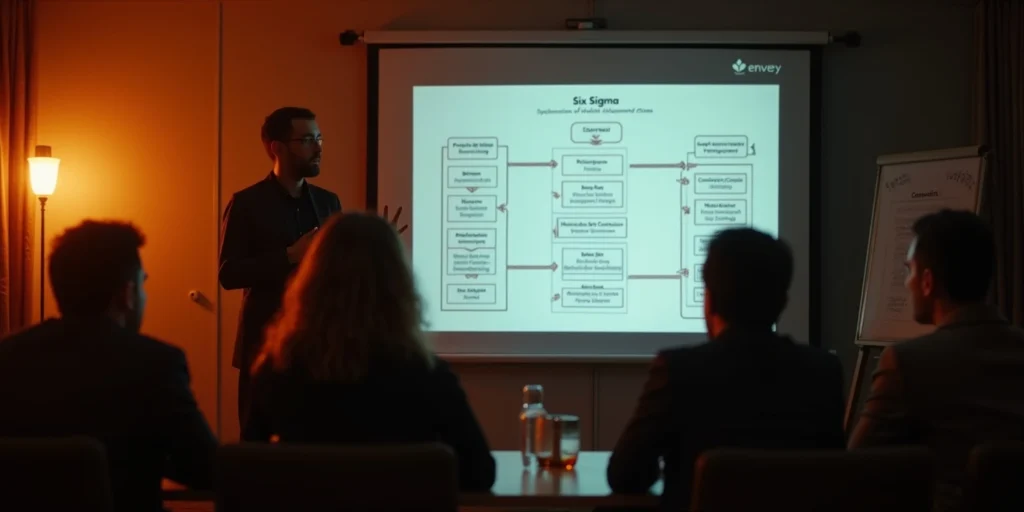With rapid changes in today’s business world, companies are aggressively speaking about improvement. They are in need of a boost in efficiency, cost-cutting, and transparent work. Process analysis technique will assist a process with the best view of that process step or series of activities involved in running business. This, along with continuous improvements, will help the company in identifying problems, clearing its work, and using its resources properly. Thus increasing productivity, decreasing costs, and higher customer satisfaction will be achieved.
Understanding Process Analysis in Business

Process analysis aims to understand, describe, and improve business processes in the BPM context through clear best practices. This involves breaking down a process into its constituent steps, assessing each for its efficiency and effectiveness, and then implementing suggested improvements. This will help an organization smoothen its processes, save costs, and enhance the quality of its offerings.
With an understanding of how processes actually operate, the organization can lessen the bottlenecks, redundancies, and areas of improvement. Such vital information enables the organization to enhance the process for efficiency and effectiveness.
Defining Process Analysis and Its Significance
A business process involves a sequence of interconnected activities or actions performed by humans or machines. It leads to the generation of a service or product for particular customers. This term is crucial in process analysis and concerns itself with the main points topical enough to analyze the process, how various things work, and how they can improve.
It is more than just noting down the steps in that process. It seeks to explore the problems by analyzing diagnostically where inefficient processes have their root cause. Analyzing the root causes therefore is an important aspect of process analysis. It goes beyond treating the mere symptoms of the problem to discover the underlying reason for the problem. When organizations learn of the root cause of a problem, they can put solutions in place that truly work long-term. This should help prevent the recurrence of the same problem and allow continuous improvements to take place. The main goal of process analysis is to increase operational efficiency. By identifying and eliminating bottlenecks, wasting due to delays, and streamlining processes within workflows, organizations can improve performance level. This also aims at reducing costs and increasing competitiveness.
How Process Analysis Drives Business Optimization
Process analysis is an ongoing process of improving how organizations work. For additional success, organizations must inculcate in their fabric a culture of continuous improvement; ways must often be checked and updated to further meet the changing business needs of their respective customers’ demands and completely align with the standards and demands of regulatory bodies. In the process, organizations usually carry out a gap analysis to understand what improvements to undertake. A gap analysis compares an existing process with that which is required to properly function. In so doing, gaps or problems are identified for corrective action. Closing such gaps helps organizations improve a process for better outcomes.
The major effect of process analysis is that it will save money. Getting rid of waste and redundancy can sometimes mean savings that put great big amounts of money back into the pockets of organizations-undoing those costs and making for more profit. Beyond cost savings, process analysis can also lead to satisfied customers, increased revenue, and better compliance with rules and regulations.
The Role of Process Mapping in Optimization

By mapping processes, we can listen to the processes more closely. It provides a good idea about the flow of operations. And that way, it is easier to see the faults, bottlenecks, and inefficiencies. That informs stakeholders about the party. By viewing the process chart, everybody gets a picture of how the work is done. This helps in searching for opportunities for improvement.
So a process map can still be a useful tool for discussion. It really helps point out where the difficult areas are and gathers the stakeholders altogether. A very good process map is a first step toward good analysis and optimization.
Techniques and Tools for Effective Process Mapping
Different process mapping techniques help to show and understand processes better and enable collaboration and alignment among stakeholders. The best technique to use depends on how complex the process is, the goals you have for the analysis, and what the stakeholders prefer. Some common process mapping techniques are:
- Flowcharts: Flowcharts use standard symbols to show the order of steps in a process. They include decisions, actions, and direction. Flowcharts are easy to read, which makes them good for simple to medium-complexity processes, and can also be adapted for complex processes.
- Swimlane Diagrams: These are also called cross-functional flowcharts. Swimlane diagrams show the process flow and highlight the roles or departments that are responsible for each step. This type of visualization is helpful for processes that involve many stakeholders or when teams share tasks.
- Value Stream Mapping (VSM): VSM shows how materials and information flow to deliver a product or service. It helps find activities that add value and those that do not. This can point out ways to reduce waste and improve processes for better efficiency.
There are also different software tools that help with process mapping and visualization. in enterprise systems. These tools have features like drag-and-drop, templates already made for you, and options for teamwork. This makes the process mapping easier and keeps stakeholders engaged.
Identifying and Eliminating Process Bottlenecks

Process bottlenecks occur in a manner whereby certain tasks get choked and piled up in a given process. This leads to delays and prevents a smooth operation from ensuing. Disconnecting and alleviating these bottlenecks provides a flow for consistency in operations so as to achieve efficiency and top performance. This comes in various forms: long waiting times, too much work piling up, or frequent equipment breakdowns, among other things.
Ignoring bottlenecks leads to higher costs, lower productivity, and unhappy customers. Identifying bottlenecks allows organizations to focus their improvement efforts on areas that will make the greatest impact.
Strategies for Identifying Bottlenecks
Bottleneck analysis helps find and fix delays in a process. It includes these steps:
| Process Mapping | First, create a map that shows how work flows. This helps find places where delays may happen. |
| Data Collection | After mapping, gather data to measure how well each step in the process is working. |
| Bottleneck Identification | Look at the data to spot bottlenecks. These are the steps that take the longest time, have high wait times, or have too much work piling up. |
| Root Cause Analysis | When a bottleneck is found, use analysis techniques to see why it’s happening. |
Knowing the root cause is key to coming up with good solutions.
Solutions for Overcoming Common Process Bottlenecks
To fix bottlenecks in processes, a mix of redesigning processes, ongoing improvement, and quick actions is often needed. Here are some common solutions:
- Process Redesign: Redesigning a process can help remove unnecessary steps, make workflows smoother, or change the order of tasks. This may include automating certain tasks, shifting resources, or using new technology.
- Continuous Improvement: Using an ongoing improvement method like Lean or Six Sigma can guide organizations to find and fix bottlenecks step by step. These methods focus on making decisions based on data and aim for small improvements over time.
- Corrective Actions: To quickly deal with bottlenecks, organizations might add more resources, lessen the workload, or put in place a short-term fix.
By using these solutions, organizations can reduce bottlenecks, improve their processes, and boost their overall efficiency and effectiveness.
Leveraging Technology for Process Improvement

The use of technology in process improvement in an organization cannot be overemphasized: it provides a very hands-on approach to improving work, automating processes, and also allows people a deep understanding of what they do. Enabled by the right technology–from process automation software to advanced analytics platforms–speed is key
Many organizations now automate repetitive tasks, streamline work collaboration, and free more employees for more critical projects. Therefore, these tools assist organizations in pushing further with their process improvement efforts. Hence, this goes a long way toward driving innovation, hence compounding their competitive edge.
Automation Tools and Their Impact on Business Processes

Increased process automation changes how companies improvement their processes; it allows firms to simplify and better their operations since it is the automation of boring activities that are usually rule-based, in that they need little operator intervention. Process automation provides a means of removing otherwise tedious work from the domain of finite human resources, giving them time and scope to concentrate on activities that require inventiveness and critical thinking. In the recent past, Robotic Process Automation (RPA) has gained momentum. Being a fairly contemporary and full-featured approach, RPA allows in automating tasks that usually require human intervention. The working methods of an RPA software robot are akin to a human using a computer system and applications. They perform activities such as data entry, invoice processing, and customer care inquiries. Automation is an essential part in accelerating workflows, improving them, and sequentially. These tools lessen and minimize the manual effort and the likelihood of mistakes occurring.
These tools enable a company to implement, run, and automate its business processes by establishing flows of tasks, which include imposing deadlines for the completion of tasks and granting visibility to the parties interested in the state of affairs. The streamlined workflow allows for higher efficiency and lower processing time, together with great assurance that each task is uniformly performed.
The Emergence of AI and Machine Learning in Process Analysis
Artificial intelligence (AI) and machine learning (ML) are changing how we analyze processes. They help organizations get better insights, predict what might happen in the future, and automate decisions. By using AI and ML, businesses can make processes better, work more efficiently, and stay ahead of the competition.
Machine learning can look at large amounts of process data. It finds patterns, trends, and unusual results that people might miss. This insight helps organizations make smart choices about improving processes, using their resources, and managing risks.
With the help of predictive analytics from AI and ML, organizations can predict future outcomes by looking at past data. They can see potential bottlenecks, find spots for early action, and improve how they use resources to stop issues before they happen. The use of AI and ML in process analysis marks a big change, helping organizations move from simply fixing problems to actively optimizing their processes.
Process Analysis in Lean Management and Six Sigma

Among the different methodologies that improve processes, Lean and Six Sigma occupy an important place, both based on reducing the wastage and the variability of a process while increasing its efficiency. While Lean looks at eliminating non-value-adding activities, Six Sigma looks at removing any defects or variations. These are developed to uplift quality and predictability.
Process analysis added to Lean and Six Sigma helps enhance these methodologies by enabling organizations to easily identify the areas of greatest potential improvement.
Integrating Process Analysis with Lean Principles
Lean manufacturing principles are derived largely from TPS. They strive to eliminate waste and assure a smooth flow of value to the customer. When organizations blend process analysis with Lean principles, the result is a win-win for their operations: increased efficiency, shortened lead times, and optimized processes.
As an important Lean tool, value stream mapping (VSM) is used to visualize how materials and information flow in delivering a good or service. By looking at the value stream, organizations can find extra steps in the process that add no value. This is usually transportation made unnecessarily, excessive inventory held, or motion wasted, among others. The very nature of the process itself then becomes more effective.
Lean principles also stimulate an alien culture of continuous improvement. The implication is that processes are consistently being evaluated and improved for better performance. Working on process analysis combining lean principles enables an organization, on a continuous basis, to identify, act on the areas needing improvement, and sustain a culture of excellence.
Six Sigma Methodologies for Process Excellence
Six Sigma is a data-driven method for eliminating defects in a process. Its primary cycle, called DMAIC, Define, Measure, Analyze, Improve and Control. Different analysis techniques are employed to facilitate this cycle which enables organizations to continuously evolve their processes. During the “Analyze” stage of DMAIC, tools such as root cause analysis and statistical process control (SPC) are used to identify the reasons for defects and variation. When organizations understand these root causes, they can devise controls to reduce variability
Six Sigma also emphasizes data-based decision making. This methodology allows organizations to identify opportunities for improvement and validate the effects of these changes in their processes. With a combination of process analysis and Six Sigma techniques and DMAIC methodology companies can reduce defect rates, elevate performance of processes and enhance customer satisfaction.
Measuring Success: KPIs and ROI from Process Analysis
It is necessary to measure the effectiveness of process analysis initiatives. It ensures that the improvements align with business goals and avail themselves of actual value. The KPIs would also facilitate process performance, in the form of succinct numbers, and track the performance over time. Setting and monitoring proper KPIs offers organizations a chance to understand the effect of changes in processes on their operations and determine which steps await further improvements.
Also, calculating the return on investment (ROI) from process analysis shows the financial gains of these efforts. This can help organizations get continued support for their process improvement work.
Key Performance Indicators (KPIs) for Process Analysis

The successful process improvement depends, in part, on properly defining KPIs. Some of these KPIs can include cycle time, error rates, use of resources, satisfaction of customers, savings in costs, and efficiency in operation. Following the KPIs keeps improvement efforts in line with the overall strategic aims of an organization. Support of continuous improvement is additionally gained. Sound KPIs make clear where special attention is required and thus guide focused initiatives for process improvement. Assessment of the indicators allows improvement processes, increases their profitability, and achieves an operational excellence culture.
Calculating Return on Investment (ROI) in Process Improvements
By measuring the financial effects of improving processes, businesses can see the real Return on Investment (ROI) they get from their work. They can look at metrics and cost-related studies to understand the efficiency gains and money saved from changes made. By keeping track of key performance indicators (KPIs) connected to their operations and customer satisfaction, companies can find out how much value their optimizations bring. This method helps businesses make smart choices based on clear data, ensuring a lasting ROI in their process improvements.
Conclusion
Process analysis, including process mining, is very important for improving business. It helps to drive efficiency and growth. By identifying and removing bottlenecks, using technology, and applying Lean and Six Sigma ideas, businesses can see real progress. To measure success, look at KPIs and ROI. This helps with continuous development and new ideas. Using process mapping techniques and automation tools can help businesses run better. Real-life case studies show how process analysis can change things for the better. To succeed in a tough market, focus on process analysis. This will help unlock your business’s potential and lead to lasting success.
Frequently Asked Questions
What Are the First Steps in Starting Process Analysis?
Start by clearly defining the process you want to analyze within the process analysis lifecycle. Make sure it aligns with business goals. Involve stakeholders to gather helpful insights. Use process discovery methods and carefully document each step. Select the right analysis techniques to find areas that can be improved.





